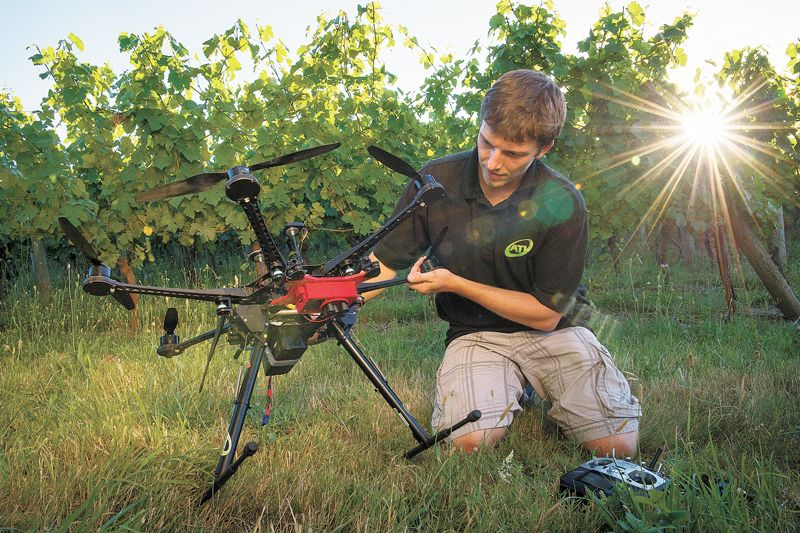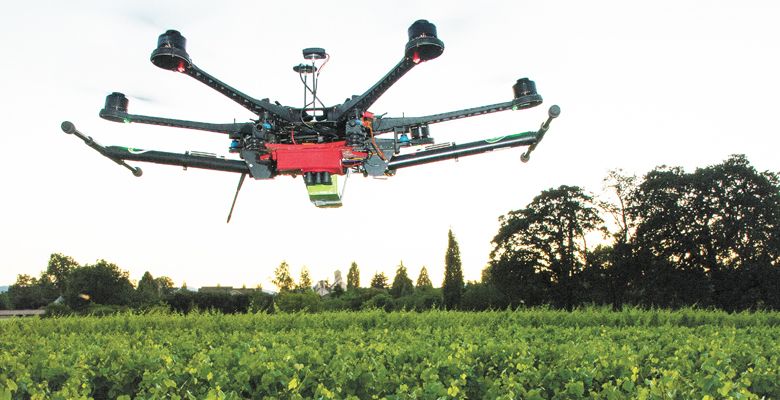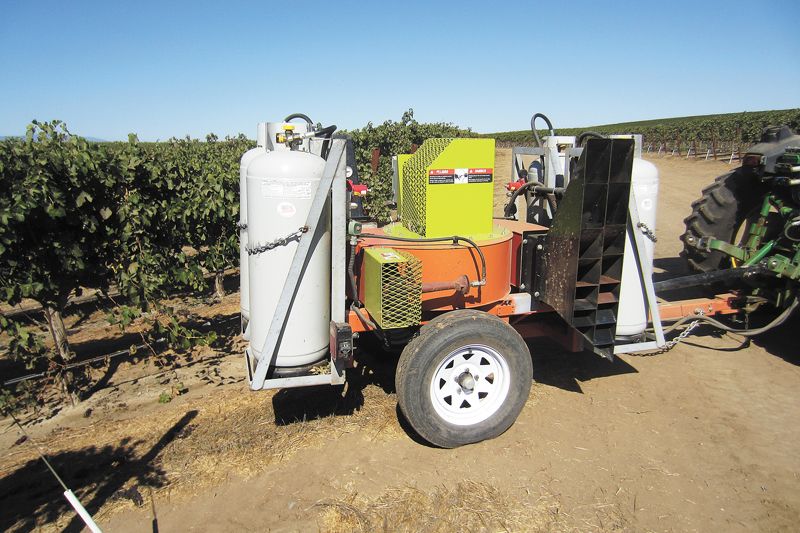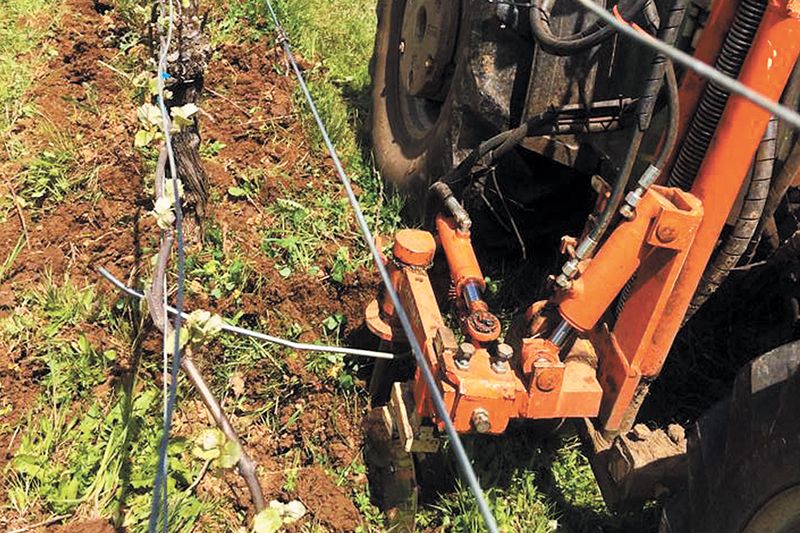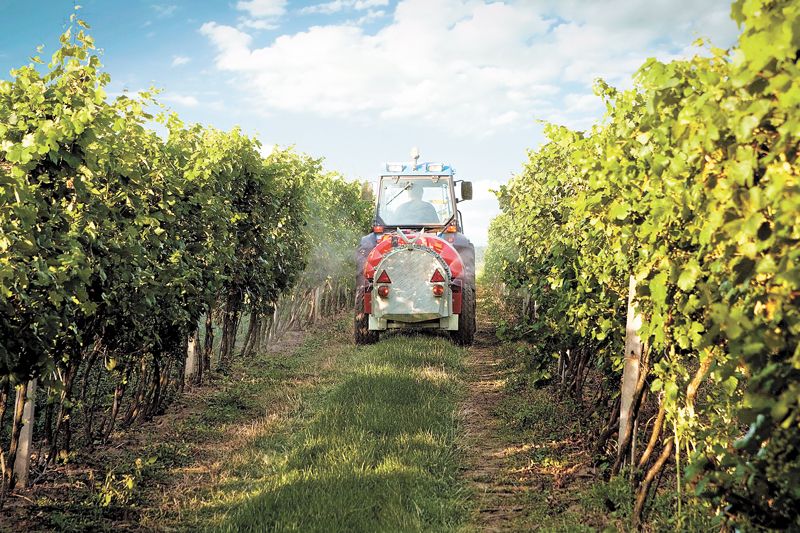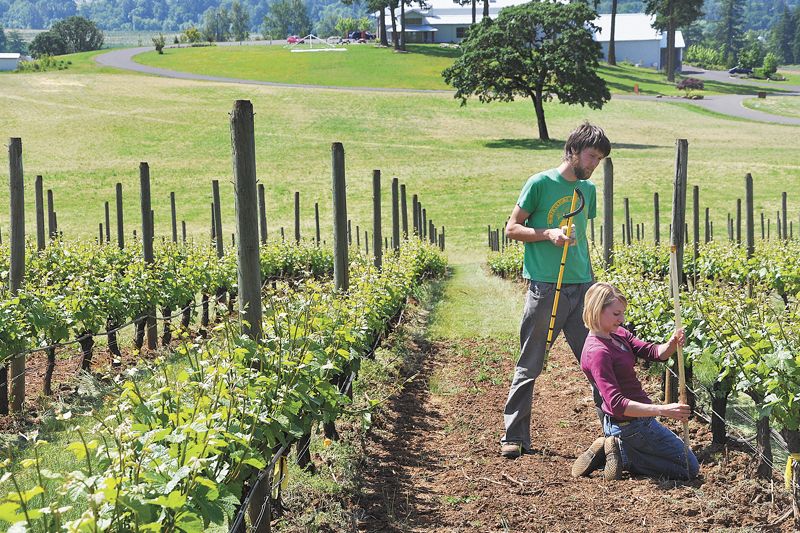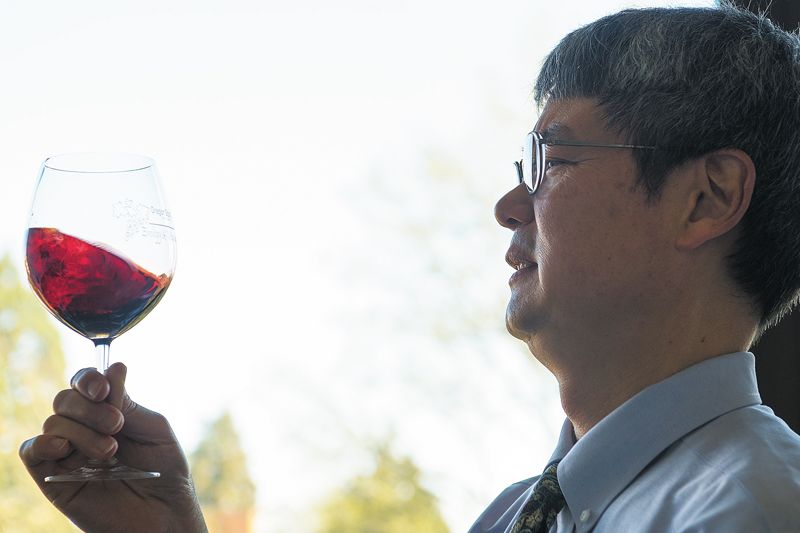Gaining Green Ground
Scientists, growers and companies innovate, seeking sustainable solutions and balance in the vineyard
It’s not easy being green. In fact, sustainability is a balancing act fit for only the most dedicated growers. Unlike the circus performer adding more plates or rings to make the feat extra dazzling, winegrowers are aiming for less.
In an effort to achieve the most sustainable vineyard possible, growers often find themselves in a balancing act of reducing inputs — herbicides, fungicides, pesticides, tractor passes — in the hope of a healthier vineyard ecosystem. But at times, eliminating one input sometimes leads to increasing another. This tension is what complicates sustainability, making spinning plates while riding on a unicycle look easy.
Groups like LIVE (Low Input Viticulture and Enology) alleviate some of the perplexity by providing useful guidelines for vineyard managers and winemakers. Chemeketa Community College’s Northwest Viticulture Center as well as Umpqua Community College’s Southern Oregon Wine Institute endorses LIVE — the schools’ teaching vineyards and wineries are both certified — for its practical and science-based approach. LIVE Director Chris Serra is a firm believer in taking the philosophy of sustainability and giving people real-world protocol.
“The often over- and misused word ‘sustainability’ gives pause to some potential practitioners,” Serra said. “Some see it as a wishy-washy or meaningless concept due to its non-universal standards. At first glance, a valid critique, but I would say that this perceived flaw is actually its greatest strength, creating regional solutions to a universal problem.”
And solutions do not simply fall out of the air — unlike spinning plates. Some result from research performed by institutions like the Oregon Wine Research Institute at Oregon State University. Led by Mark Chien, the new program coodinator, OWRI employs dedicated scientists to conduct studies that invariably increase sustainability through useful — and hopefully reasonably priced — applications.
For example, OSU Associate Professor Dr. Walt Mahaffee, PhD, a research plant pathologist for OWRI, helped develop a method and device for measuring powdery mildew (PM) inoculants in the air. For those not familiar with this voracious vineyard blight, PM is a disease caused by the fungus Uncinula necator. PM afflicts vineyards worldwide, affecting the size of the vines, the total yield of fruit, as well as resulting in off-flavors in the wine produced from infected grapes. The disease can also cause the blossoms to fall and result in failure to produce fruit. Sprays like sulfur — considered organic and most widely accepted — as well as other fungicides are used to control it.
The innovation — sold on the market as Smart-DART — offers growers a more accurate calendar of when to apply their fungicide of choice. Using this inexpensive tool, many have been able to reduce or eliminate early season spray applications and decrease the rate of sulfur — measured in pounds per acre. Less chemicals used, less diesel burned. A green tool, for sure.
“Growers who have been using it over the last eight to nine years, on average are saving 2.4 fungicide applications per growing season. Some as many as 6 or 7,” Mahaffee said.
Here is where the balancing act emerges. According to Kevin Chambers, a longtime winegrower and former Oregon Wine Board president, some growers who have reduced early season sulfur are now seeing an increased number of erineum mites, which can increase foliage damage and feed on cluster primordials, aborting them.
Was the early sulfur spray keeping the little buggers at bay? Or could the mites be connected to the reduction in late-season sulfur applications requested by winemakers? Or could it be unrelated to sulfur applied and more about overall plant nutrition? Cause and effect is not so black and white when it comes to green farming.
Fellow OSU/OWRI researcher Associate Professor Patty Skinkis conducts applied research in canopy management, vine balance and sustainable production practices. She is currently examining how to time leaf removal more efficiently in order to control botrytis, a fungus that causes an infection called gray rot, in turn, ruining the affected fruit. Her hypothesis is that by opening up the canopy at calculated times in the season, growers can reduce fungicides.
The question of balance comes into play, yet again. Is it reducing the inputs (fungicide) or simply shifting them (mechanical or manual leaf removal)?
“Maybe you have the same amount of tractor traffic (or carbon footprint), but you don’t have the fungicide going out,” Mahaffee noted. “We think that by opening up the canopy, you have better disease control, better airflow, the plant dries out faster, and then, if you do apply fungicide, you get better coverage onto the fruit, creating a better end-product.”
Research by OSU/OWRI courtesy faculty members Inga Zasada, a research plant pathologist, and Paul Schreiner, a plant physiologist, are studying choice of rootstock for nematode control.
“Any time you can go with a rootstock to manage nematodes versus fumigation, there is a substantial green effect,” Mahaffee said. “Fumigants are nasty, nasty products. Nematodes can be a big problem with replanting vineyards, which is happening a lot now.”
Schreiner is also researching the mineral nutrition of vines.
“Any time you can learn what you need or don’t need to apply is saving on sprays and tractor use,” Mahafee said. “The healthier the vines and better nutrient balance, the less susceptible they will be to disease and pests, which then translates into sustainability.
“It doesn’t quite register with people how important that is,” he continued. “What nutrients do the vines use, when are they in deficit and how does that impact wine quality? [OWRI wants to] devise ways of making sure the vines are getting the minerals they need when they need them.”
While research is crucial, growers themselves, also innovators in the field, are experimenting and with the plants, soil and terrain they know well.
For Dai Crisp, well-respected vineyard manager, winegrower and winemaker for his own label, Lumos, his environmentally friendly practices are ones he has honed since 1986.
He finds the use of multi-hydraulic tractors key to maintaining sustainability for the 120 acres of Certified Organic vines — including Temperance Hill, Logsdon Ridge and Wren, his own estate vineyard. In these central and southern Willamette Valley vineyards, he uses an in-row cultivator, which acts as an under-the-vine hoe, killing unwanted weeds without using herbicides.
“A lot of people think that this is not a sustainable practice because of the diesel used,” Crisp said. “But you have the opportunity to in-row cultivate at the same time as mowing or even spraying [fungicide].
“Any opportunity to do two jobs at the same time cuts down on fuel, cuts down on time, and it also means we are not compacting the soil with unneeded tractor passes,” Dai explained.
Tractor work is a large part of farming grapes and can be a big input to offset with its fossil fuel-burning carbon emissions, but it is essential. All growers have to figure this into their sustainability models. Reducing tractor work is what every grower desires. Draft horses, like the ones used at Illahe Vineyards in the central Willamette Valley and Walla Walla’s Cayuse Vineyards, are an option, but they are used only for certain tasks such as mowing or tilling.
Using horsepower definitely evokes the simpler days of farming the family homestead and is a refreshing idea, but in order to maximize sustainability in today’s world, growers must balance — there’s that word again — with the latest technology.
Looking forward? Crucial. Looking up? Recommended for the latest green machines. Presenting precision farming.
Companies like HoneyComb Corp in Wilsonville and Aerial Technology International in Clackamas manufacture and perform custom system integration for agricultural drones, respectively, that fly over vineyards — and other farming operations — to gather multispectral imaging from sensors made by companies like MicaSense. The California outfit also processes the data-driven images, which can give viticulturists an analysis of plant health using vegetative indices such as NDVI (Normalized Difference Vegetation Index). The use of UAVs (unmanned aerial vehicles) has made the spectral imaging easier to afford, easier to obtain and at a much higher resolution: a couple inches per pixel. Up until now this resolution has not been available.
“Manned aircraft and satellites are able to get three feet per pixel, or, at best, sometimes one foot per pixel. [At this resolution], you can’t really see individual plants and can’t see anywhere close to a leaf,” said Gabriel Torres, founder of MicaSense. “So now you are able to see individual leaves.
“What is interesting and exciting about this is the use of UAVs for classification and identification of issues, such as being able to identify powdery mildew as opposed to just fungus [from the spectral images]. That is where the revolutionary shift comes in, that’s where the paradigm starts to shift.”
Jeff Lorton, director of Yamhill County Economic Development, might be the ag drone’s most enthusiastic cheerleader. Of course, he would love to see companies invest in the area by making the UAVs in his wine country community, but he also realizes the economic impact for vineyard owners, many of whom are eager to take them for a test drive.
“The ability to fly over challenging terrain, look down at it, get this imaging, identify the problem in a specific area, so now you can treat this one part of the vineyard for, say, powdery mildew, without having to spray unneeded fungicide, is definitely green,” Lorton said. “Less inputs, less chemicals, better environmental.”
Yamaha is working on a different program using an unmanned helicopter that can spray applications. According to Lorton, Yamaha has more than 2,500, or so, unmanned mini-helicopters that spray 1.3 million acres of rice in Japan. After 30 years of this technology, the international company wants to break into the Oregon wine market.
“[Yamaha has] been working with UC Davis and have proven the technology there with professor Ken Giles,” Lorton said “They have asked to do it in Oregon in Yamhill County with Ken Wright and Results Partners, an opportunity brokered by YCED. If all goes well, they will be spraying inputs next spring.”
How is the Yamaha UAV green? Hovering about 20 feet over the vines, moving 12 mph, the RMax can spray about 12 acres an hour — compare that to a tractor’s ability to spray about one acre an hour — plus there is no soil compaction, making the RMax efficient and earth-friendly. The helicopter also addresses the impending labor shortage, which is a major factor in the sustainability of the industry as a whole.
Economically speaking, the machines are not so sustainable for a single vineyard; instead, they are really marketed to large vineyard management companies that will be required to certify any operators.
The latest technology is not just relegated to the sky. Back down on the ground, thermal plant treatment (TPT) is happening now, specifically at Adelsheim Vineyard in Newberg.
Agrothermal Systems manufactures equipment designed to blow heated air (300°F) into the canopy from propane-powered jets in order to control pests and diseases without harming the grapevine. Additional benefits include assuring fruitset and improving wine quality.
Chad Vargas, Adelsheim’s vineyard manager, trialed the technology in 2012 and expanded its use in 2013. That year, the Newberg winery executed approximately 10 passes starting at bloom. The tractor can perform the treatment at 3.5 mph and can cover about two acres per hour, depending on row spacing. The hot air travels at 35 mph through the canopy, uses about 6 gallons of propane per hour, costing about $250 each season for 10 to 12 passes. The idea is that fungicide sprays could be cut in half.
Marty Fischer, CEO of Agrothermal, is conducting more research this season on how TPT influences fruitset and how it impacts powdery mildew spores. They plan to improve the equipment design to carry smaller propane tanks with articulating heat vents adjustable for differing row widths.
While companies experiment to perfect their product, so do growers. Kevin Chambers’ newest approach is permaculture, “a system of cultivation intended to maintain permanent agriculture or horticulture by relying on renewable resources and a self-sustaining ecosystem.”
“It all boils down to when you mono-crop anything, you create disease and pestilence, period,” he said.
After selling his Resonance Vineyard in Carlton to Maison Louis Jadot in 2013, Chambers, a former-proponent of Biodynamics and co-founder of Oregon Vineyard Supply, bought 80 acres near Amity. Soon, he and his wife, Carla, will be planting a 40- to 50-acre vineyard, but first comes the orchard, an important part of his permaculture plans.
After watching a documentary on biologist and educator Stefan Sobkowiak, who has worked on transforming a typical apple orchard into self-sustaining eco-experiment, Chambers was inspired. Sobkowiak established nitrogen-fixing plants next to apple trees, followed by pear or plum trees (NAP). Additionally, he planted cover crops that served as green mulch.
“A mix of species should create a balance of organisms so that one offsets the other, pretty well mitigating your insect and disease problems — not totally — but you could probably get down to one or two sprays a season,” Chambers said.
“It is intermixing species in a planting because that is how Mother Nature does it,” he continued. “You go to a forest, and there are hundreds of species, and, lo and behold, there really is no disease problem but, instead, a healthy eco-system. That is because there is cycle in there of suppressing disease organisms with beneficial organisms, suppressing fungus with bacteria and vice versa.”
Chambers plans to use the permaculture model in his orchard. Once complete, it will be located next to the vineyard, which will be planted with two varieties of grapes with a mix of clones as well as a variety of cover crops.
“My hope would be that having 10 to 20 acres of really healthy mixed species adjacent to the vineyard will help to suppress some of my problem insects and some disease,” Chambers said. “I am looking at orienting my rows with the wind in order to maximize air movement, so that reduces powdery mildew and botrytis.
“But in the end, I will still have to spray. I am not going to be able to eliminate the problem, just reduce it.” Chambers added. “It’s all about balance.”
There’s that buzz word again.
How Multispectral Cameras Reveal Information about Plant Health
Plants absorb and reflect light differently depending on the “color” of the light. Plants typically absorb blue light and red light, and reflect green light. They also reflect a significantly greater amount of near-infrared (NIR) light, which is not visible to the human eye.
The graph above shows the “reflectance curve” of a typical plant. Reflectance is the percentage of light that is reflected by the plant. One of the most commonly used characteristics used in multispectral imaging is the ratio of NIR reflectance to red reflectance. This ratio (used in NDVI), is a good indicator of plant health.
Multispectral cameras work by imaging different “colors” of light (for example, blue, green, red and NIR). The MicaSense RedEdge multispectral camera has five imagers. Each imager has a special optical filter that allows only a very specific “color” of light to be captured.
The camera’s output, after processing, is a set of images where the value of each pixel is equal to the percent reflectance of light for that particular “color of light.” These sets of images are then “stitched” together to create geographically accurate mosaics. Mathematically combining these images yields vegetation indices (like NDVI). There are literally hundreds of vegetation indices that measure many different characteristics of a plant. Some indices for example are useful for measuring chlorophyll content of plant leaves. Other indices can be used to estimate nitrogen content. Other indices provide indications of water stress.


